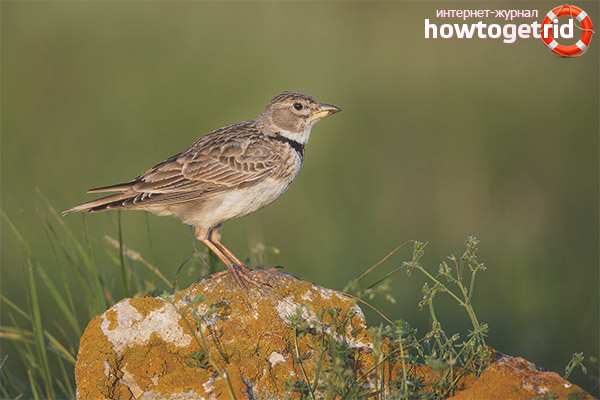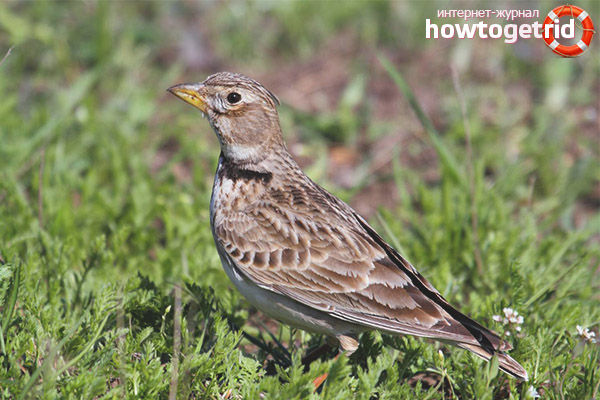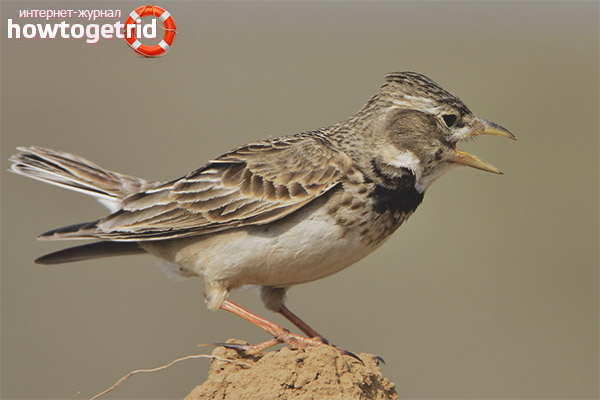The content of the article
Large birds have long been known for all their interesting behavior and mischievous trill. Today we will consider a representative of the lark family, who lives preferably in the steppe. Birds perform complex songs of different keys. Now they tremble, then they quietly hum. Their trill is familiar to many, so let's look at other features associated with this species of feathered tribe.
Description and habitat
- Lark refers to a large-sized bird, which in weight can grow up to 65 g. with a body length of 20 cm. Individuals belong to the passerine order, they are mottled in the upper part, and the chest in color is sandy.
- Beak reinforced, dense and large, bends. Paws are strong. The main feature of the feathered family of this species is the presence of a dark brown mark in the neck area.
- The signs can also be attributed to the fact that when flying in birds in the area of the wings there is a snow-white fringing on the feathers of the feathers. By gender, the female and the male almost do not differ from each other, even people with experience are mistaken about this.
- Birds are mostly distributed in Saudi Arabia, in the vastness of our homeland and neighboring states. They are also found in Portugal, Egypt and other similar countries with warm and moderate climatic conditions.
- As the name implies, birds like to live in the steppe. They prefer to be among cultivated cereal fields, as well as in grass with a decent amount of vegetation. Only warm, sun-warmed areas are chosen as the habitat.
- These birds can be attributed to migratory, but not all. Those individuals that live in warm areas do not leave warmed places. Some may travel south, but then return to their usual environment before anyone else. Massively birds fly in early spring, in some countries snow is lying at this time.
- At first, the places are occupied by individuals of male gender and begin to sing loudly. This signal indicates that beautiful ladies will arrive soon. Birds look for thaw in the sun and gather in groups. When the females arrive, the individuals will look after the nesting sites and start breeding.
Nutrition
- Birds absorb insects, thereby protecting crops from pests. Individuals do not affect cereals, they are only engaged in the collection of fallen grains.
- However, weeds can go into the food, which subsequently, along with droppings, begin to germinate in the midst of a good harvest. This ruins the grain fields. But even this fact will not block the benefits of the destruction of insects.
- Larks can eat grains and grass in the fields. Of the insects, they like weevil, locusts, flies, caterpillars with spiders, bread bugs, ants and leaf beetles.
- Due to the elongated beak they can feed on insects that live in the ground. They get them and destroy them. As for drinking, individuals often live in fresh rather than brackish watering places.
Nesting
- As soon as the considered individuals return to the nesting sites, they begin to breed after about 3 weeks. Such birds, like everyone else, nest in pairs. Often the construction of a nest takes place on the ground. Feathered birds can choose meadows, pastures and crops of crops.
- Also, the homes of such birds are often found on the boundaries, areas with sparse grass and humid places near water bodies. At the same time, the birds can make deepenings on their own or use the finished ones.They can form from traces of ungulates.
- It is worth noting that the birds make rather loose nests. They equip it with straws, dry roots and stalks of grass. The bottom of the bird is covered with thin and soft blades of grass, horse hair. Sometimes you can see the wool.
- In most cases, birds try to place their dwellings under small bushes. In such a place it is quite difficult to find the nest, besides it is in the shade. The dwelling itself is small and therefore can fit in the palms of a person.
- Often in clutch there are about 4-5 eggs. The shell has practically no shine and is painted in dirty white and yellow colors. In addition, eggs are decorated with dark patches of various sizes.
Enemies
- The most common enemies of field larks are small predators. Often, ferrets, weasels and foxes can be distinguished among them. Also, some birds prey on the feathered birds. It can be moons, falcons and crows.
- As soon as the larks begin to sing, a falcon can attack them at this time. It is during the mating season that the lark males are the most vulnerable. Some birds manage to escape from predators. Larks, as it were, fall stone down, after which they abruptly change their trajectory.
- The problem of the individuals in question is that they produce their singing at a sufficiently high height from the ground. In such a place they endanger themselves. It is the cheglock falcon that preys on such small birds in flight.
- In this case, the singer can be saved if he fulfills his signature fall in time. Unfortunately, it is during the mating season that a large number of males of the species in question die. Larks are hunted in the sky and on the earth.
Captivity
- Poultry farmers are very fond of keeping steppe larks at home. They are considered the most songbirds. Moreover, such birds are very easy to maintain. If a person begins to grow chicks and feed them from their hands, then the bird quickly gets used to it.
- So that the lark does not get bored, it is recommended to start several individuals at once. Other subspecies are permitted. Thus, the birds will not be so aggressive and shy. Birds may already begin to sing on the fifth day after capture.
The beautiful singing of larks is known to almost everyone. Such birds are not pests and are considered peaceful. However, the considered individuals have enough enemies. In the mating season, a large number of males die due to predators.
Video: Steppe Lark (Melanocorypha calandra)












Submit